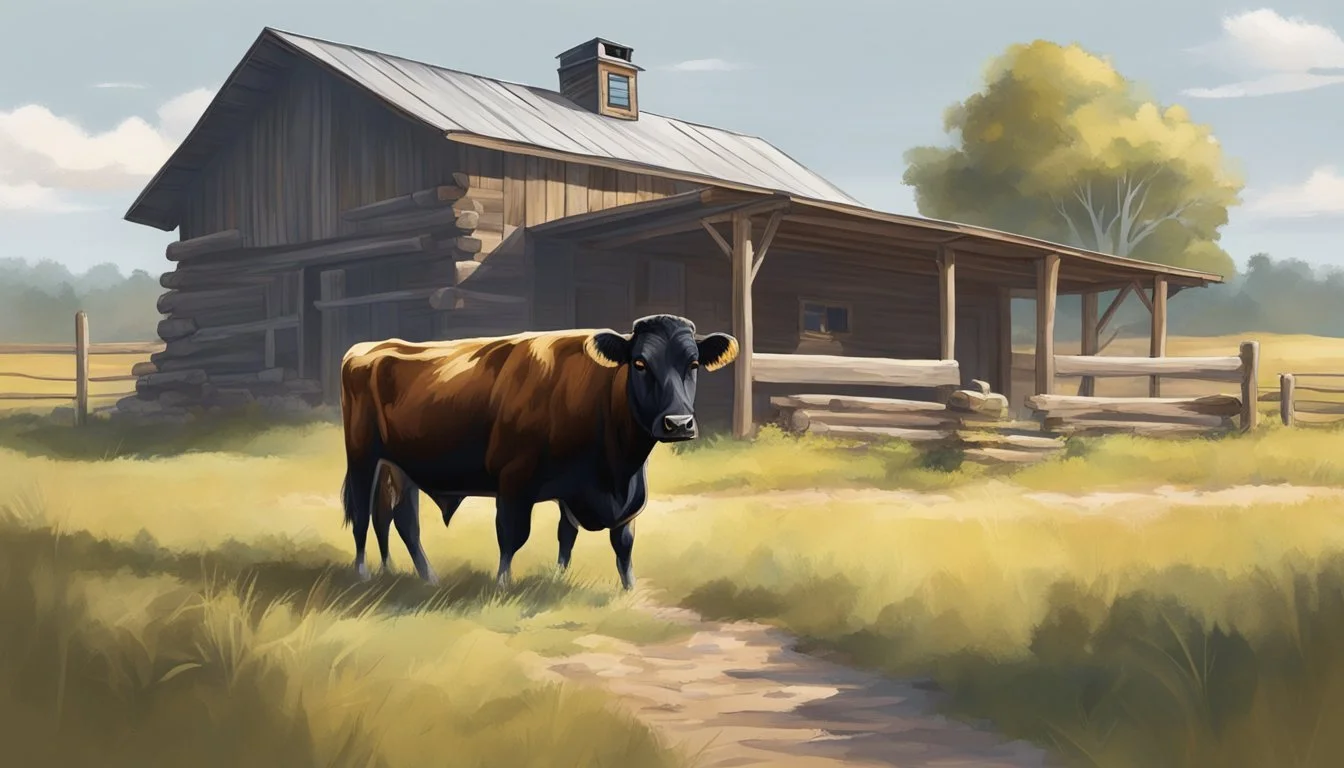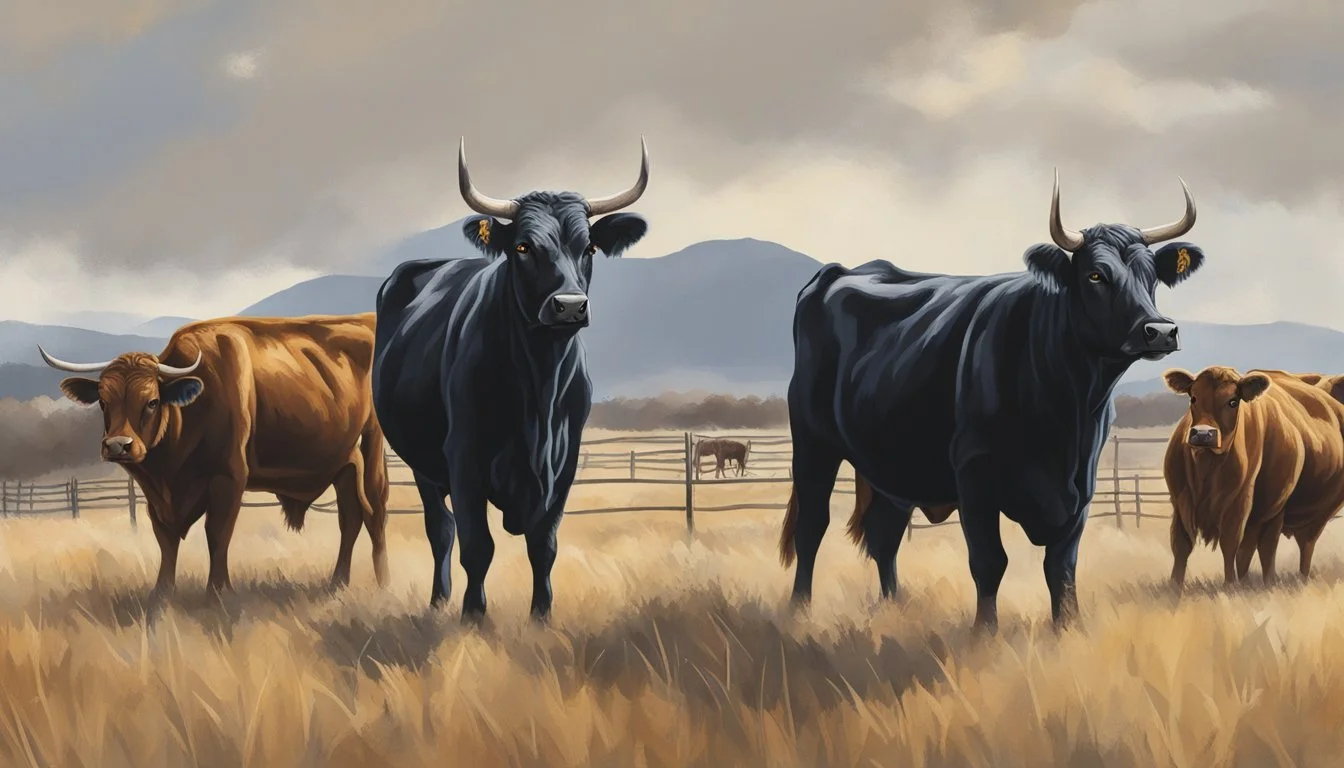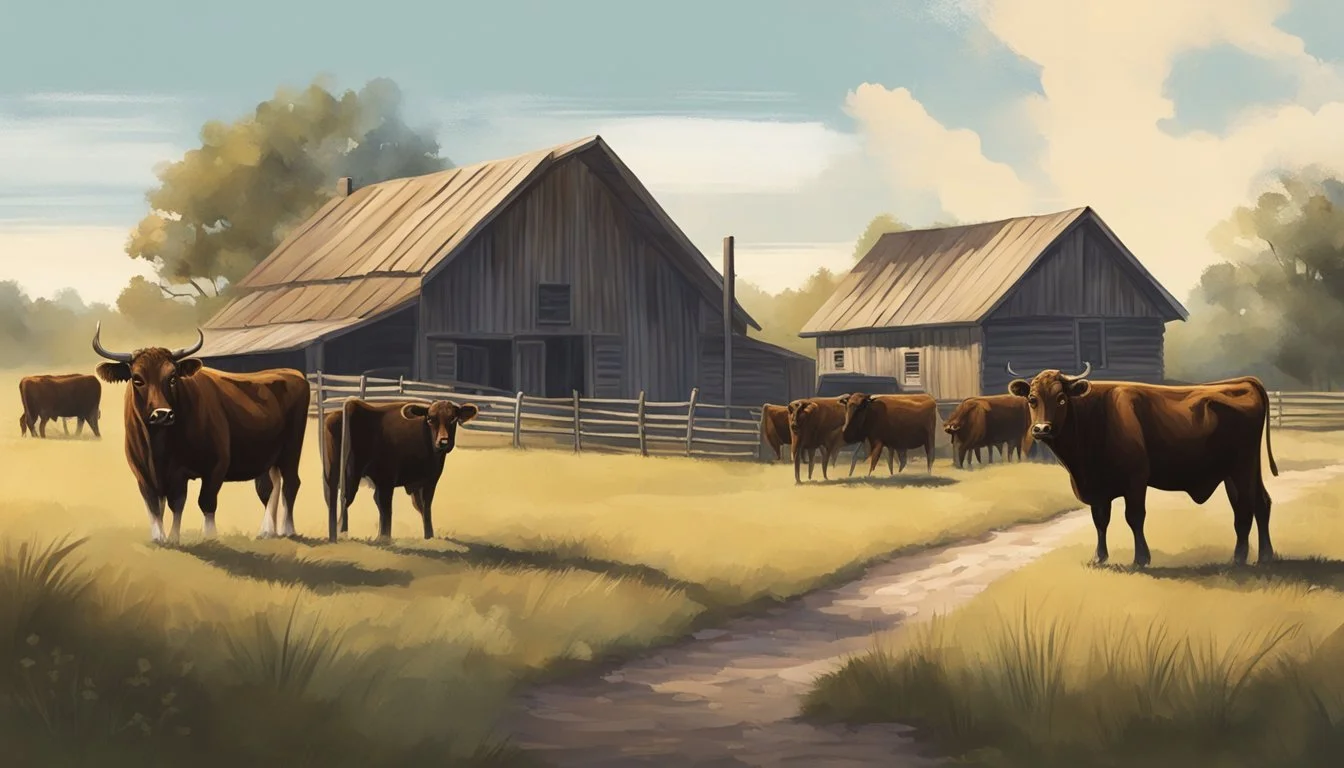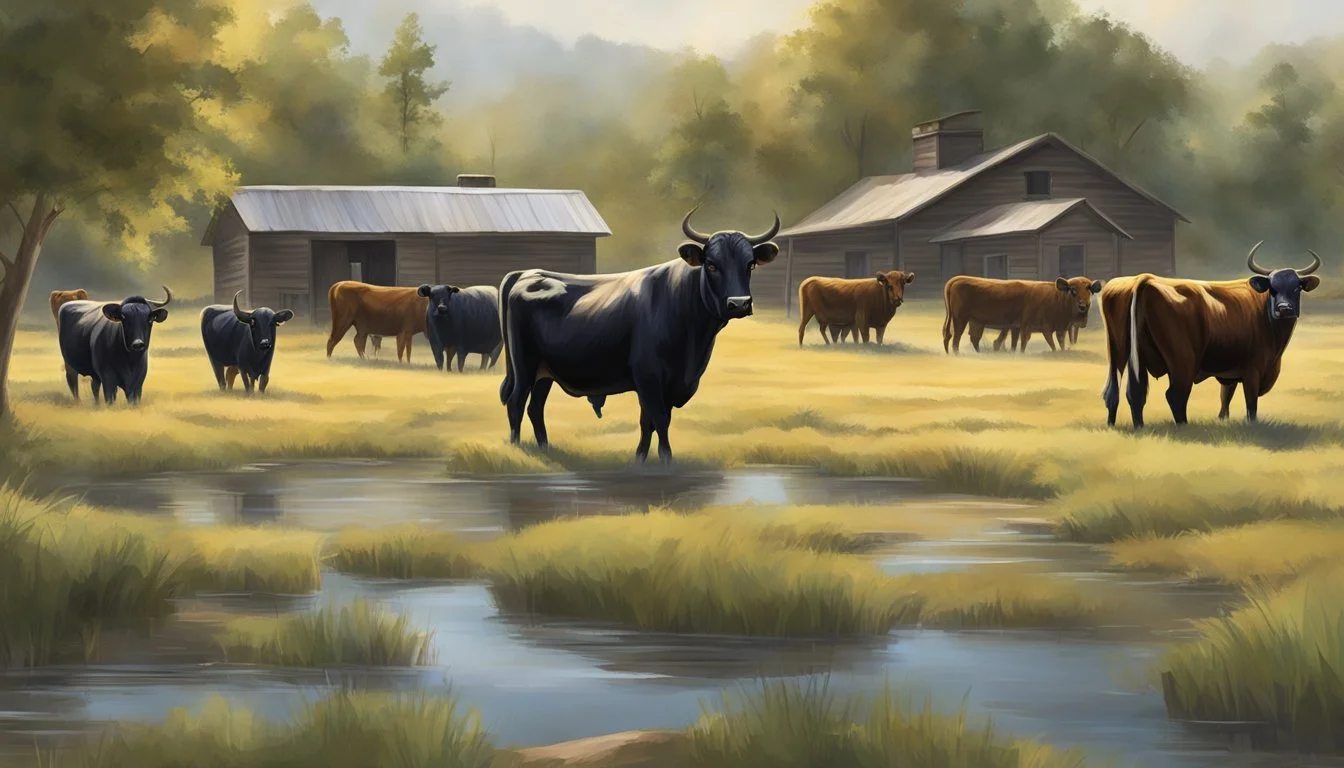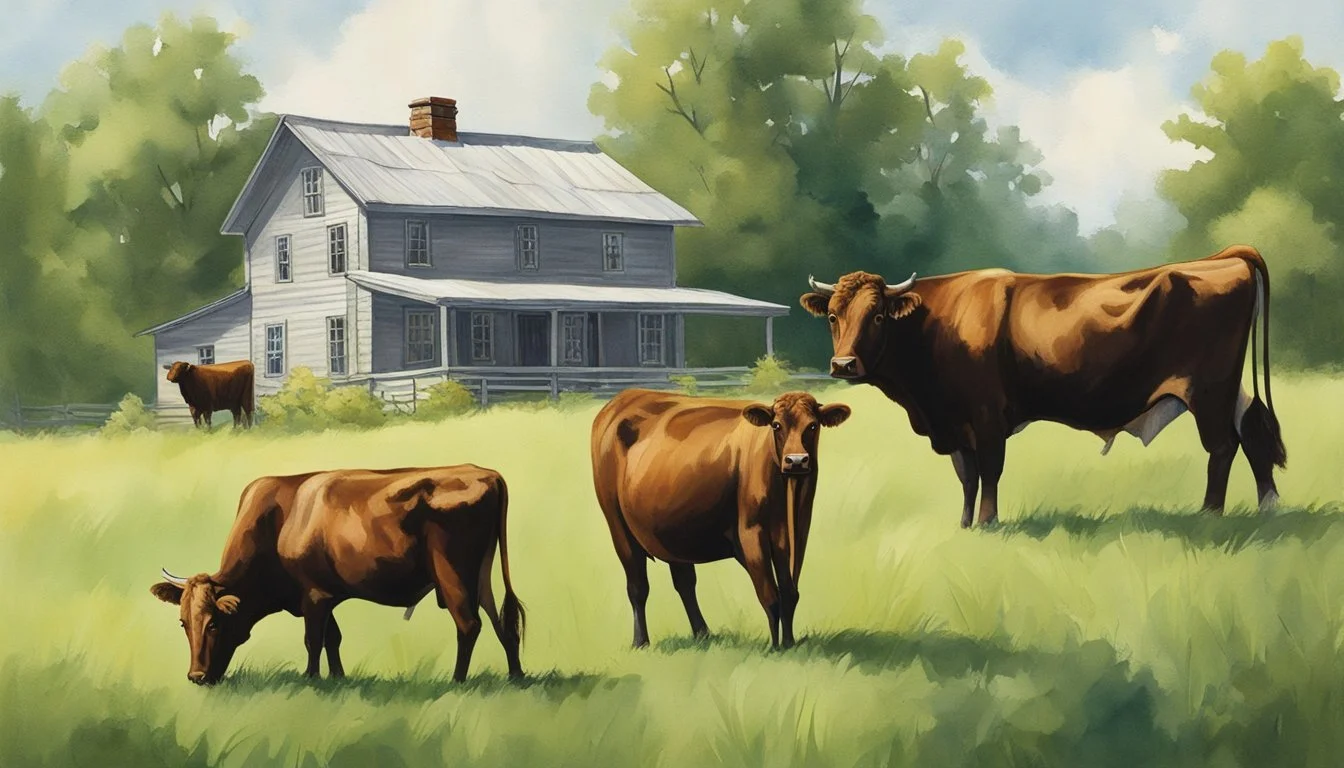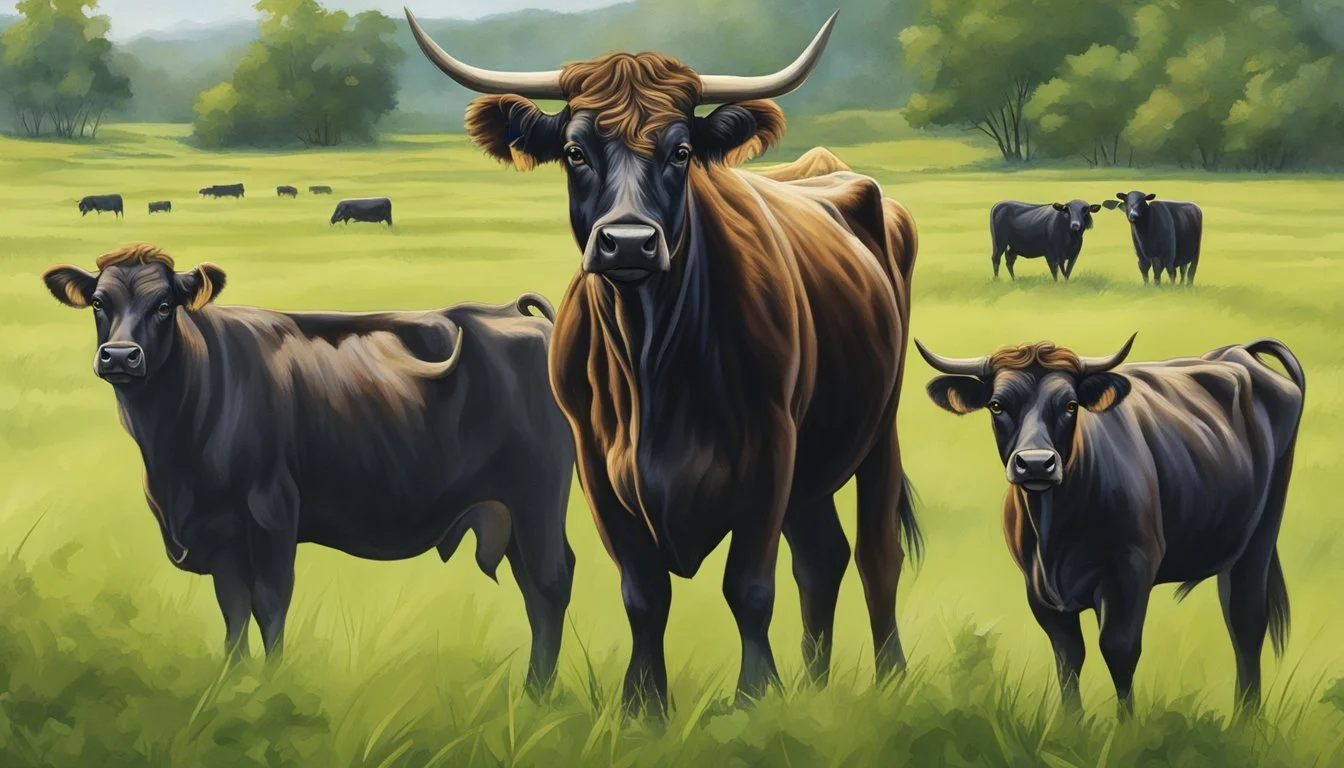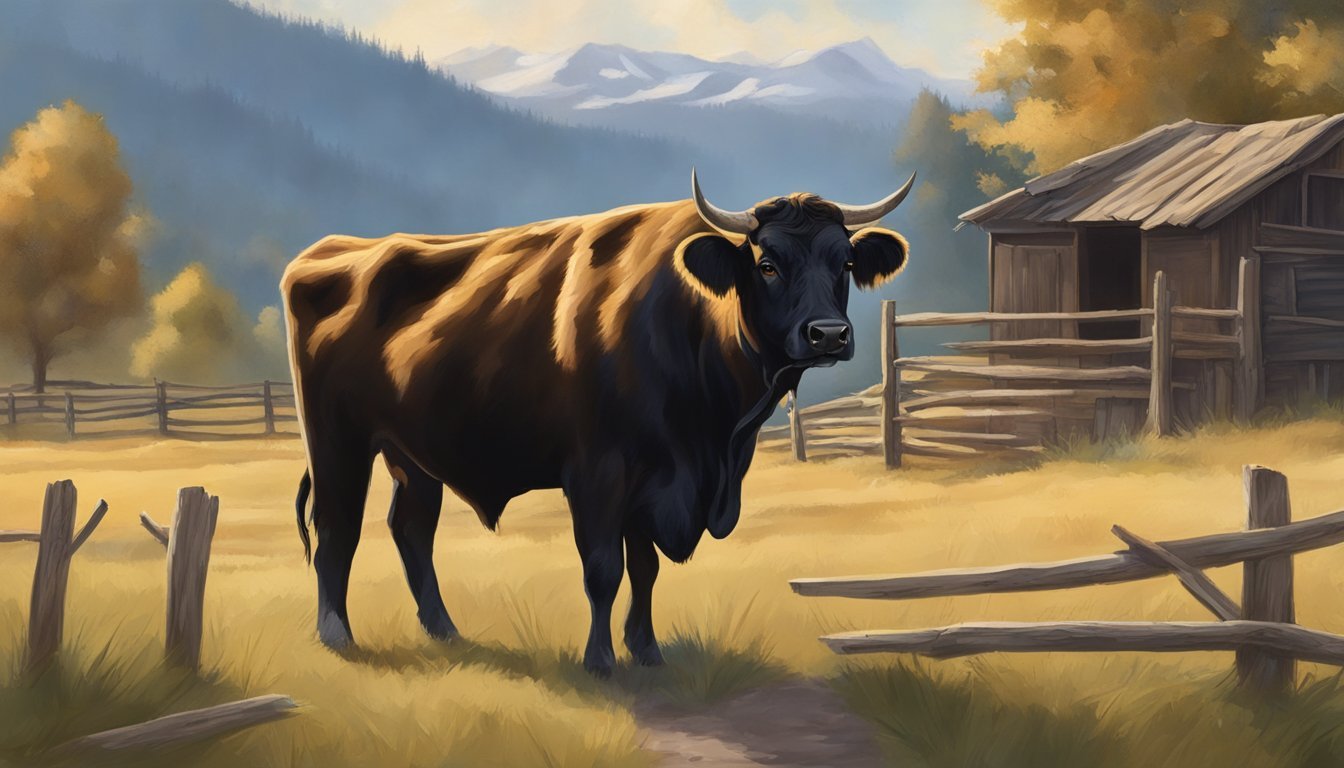Dexter Cattle and Homestead Security
Enhancing Land Protection Naturally
Dexter cattle, a dynamic and compact breed, offer more than just meat and milk for small farms and homesteads. Renowned for their adaptability and gentle temperament, these cattle serve as a subtle yet effective layer of protection for property and other livestock. Despite their smaller stature, standing no more than 44 inches at the shoulder, Dexter cattle exhibit a natural presence that can deter potential intruders from encroaching on farmland.
Beyond their physical capabilities, Dexter cattle are inherently alert and aware of their surroundings. Their strong protective instincts, combined with a disposition that is less skittish than larger breeds, make them particularly suitable for homestead security. They integrate seamlessly into a sustainable living environment, providing both valuable agricultural contributions and an additional measure of security.
Their utility in this dual role is gaining recognition among homesteading communities. Dexter cattle thrive on smaller parcels of land and can be an economical option for landowners, making them a practical choice for those looking to enhance their homestead's security naturally. As living sentinels, these mini cows contribute to the safety and productivity of the land they graze upon.
Origins and History of Dexter Cattle
Dexter cattle are an Irish breed that traces its origin back to the early 19th century. They emerged from the southwestern region of Ireland, particularly in County Kerry and County Tipperary. This small-sized, dual-purpose breed was developed by small landholders who needed cattle that could effectively provide both meat and milk on limited acreage.
Key Characteristics of Dexter Cattle:
Size: Smaller than most breeds, making them suitable for smaller farms.
Purpose: Dual-purpose, providing both milk and meat.
Colors: Predominantly black, but can also be found in dun and red.
Conformation: Known for their broad bodies and well-rounded hindquarters.
The breed’s name is believed to have been derived from a locality known as "Dexter's Ferry" close to the south coast of Cork, Ireland. Interestingly, the heritage breed of Dexter cattle was also associated with a man named Dexter, who worked as a factor on the estates of Lord Hawarden on Valentia Island.
In 1892, the English herd book was founded, which later became dedicated solely to Dexter cattle in 1924, signaling the breed’s distinct status. The Dexter Cattle Society was established to promote the breed and maintain breeding standards. By 1926, records showed substantial growth with hundreds of bulls and thousands of cows registered.
Dexters were introduced to America in the early 20th century, where they gained popularity among small-scale farmers. They continue to be valued for their versatility and efficiency as a heritage breed well-suited to homestead farming, providing robust security for farmland due to their alertness and protective nature.
Physical Characteristics of Dexter Cattle
Dexter cattle are a small, sturdy breed with distinct features that make them a preferred choice for small-scale farming. They exhibit a range of coat colors and may possess different horn types, contributing to their adaptability and visual appeal within a homestead setting.
Size and Weight
Cows: Typically weigh between 750 and 800 pounds.
Bulls: Heavier, with weights ranging from 1,000 to 1,100 pounds.
Calves: Born with an average weight of 50 pounds.
General Trait: Compact and muscular build, small size as compared to standard cattle breeds.
Dexter cattle are recognized for their smaller stature, which makes them easier to manage and less damaging to pastures.
Coat Colors and Patterns
Primary Colors: Black, red, and dun.
Dexter cows and bulls can exhibit solid colors or can occasionally have white markings.
The coloration of the coat can influence heat absorption, with darker colors typically drawing in more heat.
The breed's heritage is evident in its coat colors, with a wide variety reflecting the breed's genetic diversity.
Horn Varieties
Polled: Naturally hornless animals.
Horned: Classic horned type with a curve and forward orientation.
Horn Coloration: White with distinct black tips is common, adding to the breed's distinctive appearance.
Whether polled or horned, Dexter cattle's horns add to their rustic aesthetic and can offer natural protection for the herd.
Temperament and Behavior
Dexter cattle are generally known for their docile temperament, making them suitable for handling even by those new to cattle farming. Their gentle nature also renders them ideal for a family homestead, where individuals of varying ages and strengths are involved in daily tasks.
Children find these cattle particularly fun and educational to work with due to their manageable size and cooperative behavior. The presence of Dexter cattle can instill a sense of accomplishment in young ones as they learn the responsibilities of raising animals.
Below is an overview of the Dexter cattle's temperament and behavior traits:
Trait: Docility
Description: They are known for being even-tempered.
Trait: Suitability
Description: Ideal for beginners and family-oriented farms.
Trait: Size
Description: Their smaller stature makes them easier to manage.
Trait: Children-Friendly
Description: Safe for interaction under supervision, providing a fun experience for kids.
However, like any livestock, individual personalities can vary, and proper livestock management practices are crucial to ensure the safety and well-being of both the cattle and the people involved with them. Training and acclimation to human interaction from a young age can further improve their temperament.
Given their size and adaptability, Dexter cattle typically do not pose significant challenges when it comes to safeguarding a homestead. They can be easily integrated into small-scale farming operations and contribute to the overall security of the land through their presence and alertness to changes in their environment.
Dexter Cattle as Homestead Guardians
Dexter cattle are not typically known for their role in homestead security. These compact and versatile bovines are more recognized for their dual-purpose attributes, providing both meat and milk to homesteaders. They contribute to a sustainable homestead through efficient land use and their ability to thrive on less forage than larger breeds. Their smaller size makes them easier to manage and less intimidating for individuals just starting with livestock.
However, Dexter cattle can act as natural protectors in indirect ways. Their presence on a property adds a layer of activity which can deter some unwanted wildlife or trespassers. The cattle's natural behaviors, such as their movements and noises, can contribute to an atmosphere that signals occupancy and stewardship, thus enhancing homestead security.
Homesteaders may observe that Dexter cattle are alert and curious animals. If an intruder enters their territory, the cattle's reactions may alert homeowners of the unexpected presence. While Dexters are not aggressive, their awareness can serve as an early warning system.
In summary, while Dexter cattle are not guard animals in the traditional sense, their presence and natural behaviors can contribute to the overall security of a homestead. They play a complementary role in a sustainable homestead model by providing resources and, inadvertently, an additional dimension of awareness and deterrence.
Homesteading with Dexter Cattle
Incorporating Dexter cattle into a homesteading strategy is a practice marked by efficient pasture management and versatile utility. These small-scale bovines offer sustainable solutions for homesteaders looking to maintain their land and secure their homestead with hardworking, multi-purpose livestock.
Grazing and Pasture Management
Dexter cattle excel in managing pastures thanks to their size and efficient grazing habits. They are ideal for homesteaders aiming for grass-finished beef. They can thrive on smaller plots of land, neatly turning overgrown pastures into well-manicured fields. By systematically grazing, these cattle prevent the overgrowth of pastures, promoting a balanced ecosystem and maintaining the health of the grasslands.
Fencing and Security
Strong and reliable fencing is necessary for homestead security and the management of Dexter cattle. While their smaller stature may require less robust fencing compared to larger breeds, homesteaders should invest in sturdy fences to ensure the cattle are contained safely. Proper fencing not only secures the cattle but also protects the homestead from potential intruders.
Utility and Versatility
Dexter cattle boast remarkable versatility. As draft animals, they can be yoked to plow fields or pull wagons, which saves on machinery costs and maintenance. They are an ideal choice for small landholders who require animals that can fulfill multiple roles from a single investment. Their dual-purpose nature provides both dairy and meat products for the homesteader.
Sustainable and Eco-Friendly Practices
Homesteaders often seek sustainable and eco-friendly practices, and Dexter cattle fit these values. It is common for these animals to be grass-fed, an eco-friendlier option compared to grain-fed counterparts. Their presence on a sustainable homestead contributes to land conservation as they efficiently utilize the available pasture space and minimize the need for additional feed sources.
Health and Care
The health and well-being of Dexter cattle are pivotal for their role in homestead security and productivity. Their care involves a planned approach to nutrition, routine veterinary and maintenance needs, as well as attentive measures during calving and maternal phases.
Nutritional Requirements
Dexter cattle have adaptive diet preferences, thriving on grass-fed regimens which contribute to their hardiness. Their nutritional requirements include:
Pasture or hay: Sufficient for basic needs.
Grain-fed supplements: Necessary during periods of high metabolic demand, like lactation or growth.
Butterfat milk: High in quality, beneficial when Dexters are used for dairy purposes.
Providing supplemental feeding during the winter or in less fertile environments ensures that they maintain their health and productivity.
Veterinary and Maintenance Needs
Consistent veterinary care is crucial for long-term health. Key practices include:
Vaccinations: Adhering to a schedule to prevent common diseases.
Parasite control: Regular deworming and external parasite management.
Hoof trimming: Periodic maintenance to avoid issues from uneven wear.
Routine check-ups should be scheduled with a veterinarian to monitor overall health and prevent potential issues from escalating.
Calving and Maternal Care
Dexter cattle are known for their ease of calving and strong maternal instincts, which contribute to their longevity and the viability of the breed on a homestead. Important factors are:
Easy calving: Intervention is rarely needed due to their size and breed traits.
Maternal care: They exhibit high maternal instincts, ensuring calf safety and growth.
Health monitoring: Post-calving veterinary checks to ensure both cow and calf are healthy.
Careful attention during the calving process ensures the sustenance of these beneficial qualities in the herd.
Breeding Dexter Cattle
Breeding Dexter Cattle involves adhering to specific practices and carefully selecting breeding stock to maintain the health and productivity of this small, dual-purpose breed.
Breeding Practices
Dexter cattle generally exhibit good fertility, which is a desirable trait for breeders aiming to sustain or increase their herd size. It's important to understand their reproductive cycle to time breeding efforts appropriately. A typical gestation period for Dexter cattle is around 283 days, with some natural variation expected. Heifer calves may be born after a slightly shorter gestation, with bull calves possibly requiring a few more days.
Effective breeding practices also include monitoring for signs of estrus, or heat, and keeping accurate records of breeding dates. Breeders can adopt natural mating or artificial insemination techniques, depending on their operational resources and herd goals. Regular health checks and a nutritionally balanced diet support reproductive success and healthy calving.
Selecting Breeding Stock
When selecting breeding stock, attention to genetic traits is paramount to ensure the perpetuation of the breed's desirable attributes. Breeders should prioritize:
Health: Vigorous cattle free from genetic defects.
Temperament: Calm and manageable temperament for safe handling.
Size: Appropriate stature for the breed; Dexter cattle are smaller than average cattle, making them ideal for smaller farms.
Milk and Meat Quality: Ability to produce quality milk and meat, reflecting the breed's dual-purpose nature.
By choosing strong, healthy bulls and receptive, well-conformed cows, breeders can contribute to the quality and sustainability of the Dexter cattle population. They must work within established breed associations and networks to ensure pedigree and maintain breed standards.
Dexter Cattle for Milk Production
For those invested in small-scale dairy production, Dexter cattle stand out due to their manageable size and the superior quality of their milk. These cattle produce milk that is higher in butterfat and protein, making it particularly well-suited for cheese and butter making.
Milk Production and Quality
Milk Yield: Dexter cows are capable of producing a daily average of 1.5 to 2.5 gallons of milk. While this is lower than larger dairy breeds, the quality of Dexter milk is noteworthy. It is rich, boasting a butterfat content that typically ranges around 4 percent.
Butterfat: Dexter cattle's milk is prized for its high butterfat content, which averages at about 4 percent, lending to a creamy texture and richer flavor.
Protein: The protein content is also high in Dexter milk, which contributes to its nutritional value and makes it excellent for the dairy product manufacturing process.
Quality: The milk from Dexter cattle is often described as having a thicker consistency and creamier texture due to the high levels of butterfat and protein, making it particularly coveted for artisanal dairy production.
Dairy Management for Small Farms
On small farms, managing a Dexter cow for dairy involves particular attention to their diet and environment, to ensure optimal milk production and animal welfare.
Diet: Feed quality directly impacts milk production and quality, with a balance of forage and grains recommended for maintaining the desired levels of milk fat and protein.
Environment: Dexter cattle thrive in various climates and are known for their hardiness. Their small stature makes them ideal for smaller pastures, easily adaptable to the limited space of a small farm setup.
Caring for Dexter cattle as part of a dairy operation also means being mindful of their calving patterns and lactation periods, to maintain a steady supply of their high-quality milk.
Dexter Cattle for Meat Production
Dexter cattle are celebrated for their capacity to produce high-quality beef suited for small-scale meat production. Their meat is known for its excellent flavor, whether grain-fed or grass-fed, and a single animal can yield approximately 400 pounds of meat.
Meat Quality and Market
Dexter cattle meat is known for its excellent flavor and quality. These small-sized cows yield beef that is rich in taste and has a tender texture. The meat from Dexter cattle is a premium market product, often sought after by consumers who prefer grass-fed beef. This demand positions Dexter cattle as a lucrative option for homesteaders and small farms. In terms of market potential, the meat has a niche appeal, especially for those who are looking for beef from cattle raised in a more sustainable and ethical manner compared to large-scale industrial operations.
Typical yield: 400 pounds of meat per animal
Preferred feeding practices:
Grass-fed for enhanced flavor
Grain-fed for quicker weight gain
Market characteristics:
Niche market with high-quality standards
Appeals to consumers looking for sustainable beef options
Processing and Butchering
Processing and butchering Dexter cattle should be approached with precision to make the most out of their smaller size. They typically reach slaughter weight more quickly than larger breeds, which can result in savings on feed and maintenance. The butchering process can be managed through local processors who are familiar with small breed cattle. It is vital to ensure that the meat is processed under clean and humane conditions, following all regulatory guidelines to maintain meat quality and safety. Cooperation with a trusted butcher can help to customize the cuts of meat to meet market demands and consumer preferences.
Optimal slaughter weight: Reached sooner than larger breeds
Butchering:
Tailored approach for small-sized cattle
Custom cut options to satisfy consumer demand
Ensure processing in clean and humane conditions
Comparing Dexter Cattle to Other Breeds
In examining the role of Dexter cattle as natural protectors on a homestead, it's essential to compare them to commercial breeds in terms of size, characteristics, and their overall role as a dual-purpose breed.
Dexter vs. Commercial Breeds
Dexter cattle are relatively smaller than many commercial beef breeds like Herefords or Angus and dairy breeds like Holsteins. Their diminutive size makes them more manageable and less intimidating for small-scale farmers. Specifically, Dexter bulls typically weigh between 1,000 to 1,200 pounds, while females weigh between 750 to 850 pounds. In contrast, a Holstein cow, a common dairy breed, can weigh over 1,500 pounds. Dexter cattle's small size contributes to their versatility and adaptability, allowing them to thrive on less pasture and making them suitable for smaller land areas.
Advantages of Dexter Cattle
Size: Dexter cattle's small stature allows for easier handling and reduced feed costs.
Dual-Purpose: This breed excels in both milk and beef production, offering a versatile option for homesteaders.
Hardiness: Dexter cattle are known for their resilience in diverse climates, contributing to fewer veterinary costs.
Dexters are considered a dual-purpose breed, appreciated for the quality of both their meat and milk. Homesteaders find an advantage in their "do-it-all" nature, enabling the maximization of smaller plots of land. The meat is high quality, with good marbling, fine texture, and a reputation for being flavorful and tender.
Challenges and Disadvantages
Dwarfism: A genetic trait known as 'dwarfism' can be a breeding concern.
Market Presence: They are less common in commercial markets compared to larger breeds, which may pose some marketing challenges.
While Dexter cattle have many advantages, they are not without their challenges. Breeders must be cautious of genetic issues such as 'dwarfism' which affects some Dexter bloodlines; careful management is required to avoid passing on this trait. Their smaller size, while an advantage in some instances, may also be a disadvantage in the commercial market where larger cuts of beef are often in higher demand.
The Dexter Cattle Breeders Community
The Dexter Cattle Breeders Community is a robust network of enthusiasts and professionals dedicated to the breeding and management of Dexter cattle. They play a crucial role in sustaining the breed's characteristics and promoting its capabilities as compact, dual-purpose livestock.
Breeders often collaborate through platforms like social media groups, where they exchange insights on the history, science, genetics, and best management practices for Dexter cattle. A prominent organization at the heart of this community is the American Dexter Cattle Association (ADCA), which has been serving its members since 1957. The ADCA provides a comprehensive infrastructure for pedigree searches, enabling breeders to trace lineage and make informed breeding decisions.
Key Functions of Breeders in the Community:
Enhance the Breed: Selection for attributes like temperament, size, and milk or meat yield.
Educate New Breeders: Mentorship on breeding techniques and animal husbandry.
Maintain Records: Registration and record-keeping for pedigree and lineage tracking.
Services by the American Dexter Cattle Association:
Pedigree Certification
Breed Standards Maintenance
Educational Resources
Member Communications
Breeders across the United States are known to practice responsible breeding by considering factors such as genetic diversity and health. Many prioritize the rearing of Dexter cattle in free-range systems, emphasizing animal welfare and natural rearing practices. The breeders collectively aim to support the continuity and improvement of the Dexter breed, handing down hardy and efficient cattle to future generations.
Starting with Dexter Cattle
Before delving into the world of Dexter cattle, prospective owners should focus on selecting the right animals, preparing their homestead infrastructure, and aligning their long-term objectives with the traits and maintenance needs of these animals.
Choosing Your First Dexter
When selecting Dexter cattle, one should look for health and temperament as critical traits. Beginners should start with a smaller herd, potentially purchasing from reputable sources within the Dexter cattle market known for sustainably raised livestock. Understanding the origins and genetic background can help homesteaders and preppers ensure they procure cattle without hereditary health issues.
Traits to consider:
Hardy nature
Docile temperament
Good foraging ability
Infrastructure and Setup
Fencing: Adequate fencing is imperative to safeguard Dexters and is typically comprised of four to five strands of barbed wire or secure wooden fences. Electric fencing can also be a versatile option for these agile, smaller-sized cattle.
Shelter and Water: Basic shelters protect from extreme weather, while consistent access to clean water is a must.
Pasture: Dexter cattle excel on pasture, making them a sustainable choice for maintaining a homestead. They are efficient grazers that can thrive on smaller land parcels – as little as half an acre per animal.
Long-Term Plans and Goals
Owners should adopt a forward-looking approach when integrating Dexter cattle into their homestead. They should balance immediate needs for charm and companionship with long-term sustainability goals. Regular maintenance tasks, veterinary care, and breeding plans have to be contemplated early on.
For a sustainable homestead:
Plan rotational grazing to manage pasture health
Consider the Dexter's dual-purpose nature for both milk and meat production
Engage with Dexter cattle associations to stay informed and connected within the community.
Conclusion
Dexter cattle have proven to be an indispensable asset for homestead security and utility, offering a significant range of benefits.
Summary of Dexter Cattle as Homestead Allies
Dexter cattle are renowned for their dual-service capabilities, providing both dairy and meat products, which lends a sense of fulfillment to the owners. These compact and hardy animals guard the homestead by alerting owners to unfamiliar presences with their sensitive instincts. Owners value this breed for its minimal resource requirements and the efficient conversion of feed to high-quality produce.
Future Prospects for Dexter Cattle Owners
The market for Dexter cattle is positioned favorably amidst rural trends towards sustainable and manageable farming practices. This breed's adaptability supports a positive outlook for future prospects. Owners are likely to benefit from the ongoing interest in farm-to-table movements and localizing food sources. The legacy of Dexter cattle as a versatile homestead ally is set to be fortified by these evolving trends.
References
Mother Farmland
The article from Mother Farmland provides insights on the physical characteristics of Dexter cattle, including height, weight, and color variations.Homesteading Forum
This source compares the suitability of Dexter and Highland cattle for the Indiana climate, mentioning a specific concern with Dexter cattle and dwarfism.Homesteading
The Homesteading source highlights the value of Dexter cattle for preppers and those with limited space and budget, emphasizing their efficiency.The Paleo Mama
The Paleo Mama discusses the history and heritage of Dexter cattle, tracing their lineage back to Irish mountain cattle from around 1750.Mother Earth News
Mother Earth News focuses on the utility of Dexter cattle for small farms, noting their size and versatility as a compact and diverse breed.
Each of these sources contributes to a nuanced understanding of Dexter cattle's role as both livestock and potential protectors in a homesteading environment. They provide information based on specific aspects like size, climate adaptability, and historical background, which are essential to understanding the suitability and functionality of Dexter cattle in safeguarding homesteads.

